Umphrey’s McGee: All In Time
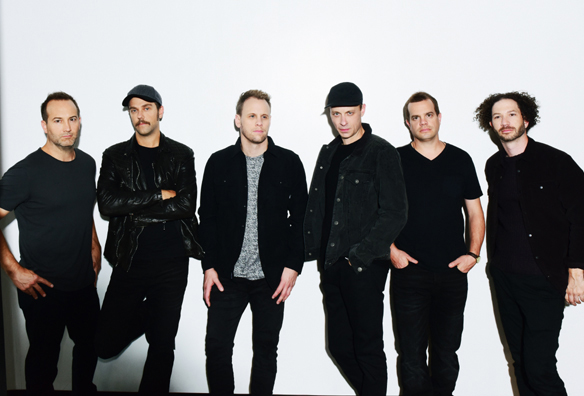
“What About ‘Bob?’”
This is the question that Umphrey’s McGee co-founder Brendan Bayliss poses with a laugh from the confines of his music room in Chicago. He’s just returned home to spend a couple of days with his wife and three young children, following a whirlwind stretch in Manhattan that included multiple press opportunities in support of the band’s new album, it’s not us, as well as a three-night stand at the Beacon Theatre.
The group’s concluding show coincided with a significant date in its history. Twenty years earlier, on Jan. 21, 1998, singer/guitarist Bayliss took the stage alongside fellow Notre Dame students—bassist Ryan Stasik, keyboardist Joel Cummins and drummer Mike Mirro—at Bridget McGuire’s Filling Station in South Bend, Ind., for Umphrey’s McGee’s premiere performance. OK, technically, they may have been called Fat Tony, after the gangster in The Simpsons but, for all intents and purposes, this was UM’s opening salvo.
When the band stepped onstage for its anniversary on Jan. 21, 2018, the original four- piece had long since morphed into a sextet, with Bayliss, Stasik and Cummins joined by guitarist/singer Jake Cinninger, drummer Kris Myers and percussionist Andy Farag. Still, the band members’ collective aims and objectives hadn’t varied markedly from those of the four undergrads who had left their prior groups, fused into a new project, relocated to Chicago after graduation and then steadily expanded their ambit across the continent.
To underscore this point, Bayliss addressed the audience and the occasion: “On behalf of the band and the crew, I just want to thank you for the last 20 years. It’s still very surreal to us and, because of you, our dreams became our reality. So, thank you so much. Tonight, we’re going to take you backward through time over the last 20 years. We’re going to play a song that we debuted each year over the last 20 years. We’re gonna start with something new and we’re gonna end with something old. And we hope you like it.”
With that, the group launched into “Half Delayed,” the meditative, alluring fourth track from it’s not us.
By the time setbreak arrived at the Beacon, many fans both in person and online started speculating as to what rarities the band might unearth as UM moved through the progression that Cummins later described, with a nod to Phish, as “going backwards down the debut line.”
At Bridget McGuire’s in January 1998, the group took the bold step of opening the show with the Bayliss/Stasik original “Bob,” a tune that also would appear a few months later on the band’s debut album, Greatest Hits Volume III. Umphrey’s had shelved the song by mid-1999, subsequently performing it once in 2000 and another time in 2003 before resuscitating it for a final appearance 10 years later.
Yet, on this occasion, Umphrey’s opted to go another way. The evening culminated with “All in Time,” a composition that the group had first performed at its fourth gig on Feb. 7, 1998 at Benchwarmers, a sports bar in South Bend.
So what about “Bob?”
“I didn’t even give it a chance,” Bayliss acknowledges. “In the beginning, it’s more about quantity; you’re trying to fill two hours. But over time, you develop the skill of songwriting and you have a better filter to gauge what’s good and what’s bad. So while there’s something to be said about nostalgia, about the novelty of revisiting an old memory, there’s also something to be said about quality and pride. From the very beginning, we’ve been concerned about winning over new ears, and playing ‘Bob’ is just not going to do that.”
However, the material on it’s not us just might. A range of media outlets attested to this by extending invitations to Umphrey’s during the group’s Manhattan press days. Indeed, the new record maintains the eclecticism and ambition of the band’s earliest efforts as refracted through two decades of evolving songcraft and studio command.
Notre Dame freshman Ryan Stasik first took note of sophomore Brendan Bayliss in 1995 when he heard him perform “Rainbow Connection,” Kermit the Frog’s signature tune from The Muppet Movie, on banjo at AcoustiCafé in the school’s student center.
“It piqued my interest,” Stasik recalls, “a longhaired hippie dude playing Kermit the Frog on a Thursday night. I was the guy who had been going around to all the lunch tables asking, ‘Who wants to play music? Who wants start a band and jam?’ Later, Brendan came into the basement of Keenan Hall where I was rehearsing. We were both into the Allman Brothers Band, the Grateful Dead and Phish and, though I was more into heavy metal and he was more into the acoustic side, our personalities and our interests meshed.”
Bayliss adds, “When he first introduced himself to me, he was wearing a French beret and was like, ‘Hi, I’m Pony.’ [Stasik’s nickname is taken from a character in S.E. Hinton’s The Outsiders.] He was always the outgoing, social giant. He’s the kind of person that will get on an airplane and become best friends with the guy he’s sitting next to. I’ll put my headphones on and look out the window.”
The pair soon formed a four-piece, Tashi Station, named after Tosche Station, the gathering place on the planet of Tatooine in Star Wars where, as Bayliss explains, “Luke Skywalker was gonna waste time with his friends. I didn’t have an amp and Pony said, ‘I’ll play bass. You can have my guitar and you can have my amp.’ Something about his conviction made me believe in myself enough that he and I started a band. Then within about a year, we conspired to break up Joel’s band, break up our band and merge the two.”
Cummins remembers his own initial encounter with Stasik. “I was standing outside a business class that I didn’t really want to go to. Ryan saw me and, before I could walk in, he persuaded me it would be more fun to go get coffee with him. We’d lived in the same dorm, Alumni Hall, and I think he’d heard me play in the chapel for fun. I also figured he’d seen me play with my band at one point. The first time we hung out, he sat me down and said that he wanted to be a musician.”
As for Bayliss, Cummins spotted him in a classroom but missed the limited window in which to strike up a conversation. “Brendan joined a music-theory course I was in. There were all really dorky music students, and I saw this dude with long hair and thought, ‘Finally, somebody I can talk to.’ But he lasted less than a week in the class.”
The two eventually crossed paths through the Notre Dame live-music circuit where Cummins was playing in a group called Stomper Bob. Mostly known as a cover band (although they did release an album of original music), the personnel varied from year to year, which shifted the band’s repertoire from rock to jump swing.
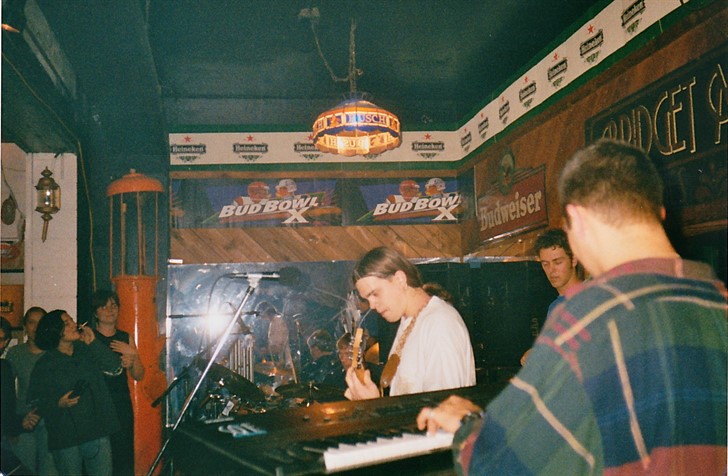 Umphrey’s McGee playing as Fat Tony during their first show
Umphrey’s McGee playing as Fat Tony during their first show
In May 1997, just after the spring semester ended, Bayliss and Stasik joined Cummins at his apartment for a jam session, which also included fellow ND student and Stomper Bob drummer Mike Mirro. When school resumed in the fall, so did the occasional get-togethers, leading to a fateful day in November, when Bayliss and Stasik invited Cummins and Mirro to dinner and delivered an overture.
The keyboard player recalls, “They said, ‘We want to do this for a living and we’re in a band with two guys who don’t want to do that. So if you guys want to do this with us, then we’ll quit our band if you quit your band. Mike and I talked about it in the parking lot and we agreed to do so. I went home that night, and it didn’t go so well. I was living with the bass player, along with other people. But we ended it and showed up the next day at their house to tell them: ‘OK, we did it!’ And they were like, ‘Oh, you actually did it? Shit…’ And we were like, ‘You didn’t? What the fuck?’ So they said, ‘OK, we’ll get them over here and do it today.’ That was the end of November 1997 and we practiced and wrote music almost every day afterward.”
“I felt bad at first,” Bayliss admits, “because Gregg Andrulis, the original keyboardist, had been about to go study abroad and we convinced him to stay. Then, six months later, we broke up the band. So I apologize to Gregg [who went on to pursue a career as a mechanical engineer]. But he’s since come back to shows, we’ve reconnected and he’s very proud of us.”
The group’s first concert was a two-set affair, reflecting the players’ commitment to the new unit as well as the range of their musical interests. Following the “Bob” opener, which the band had to restart 15 seconds into the song due to a power failure (which proved nothing of an ill omen), they moved into a version of Billy Cobham’s “Red Baron.” Other artists that the quartet covered that night included Talking Heads (“Burning Down the House”), Ben Folds Five (“Philosophy”), Led Zeppelin (“Moby Dick”), Def Leppard (“Pour Some Sugar on Me”) and Phish (“Mike’s Song> I Am Hydrogen> Weekapaug Groove,” “Bathtub Gin”).
The group also peppered the evening with seven originals that they had worked up over the preceding weeks, including “Divisions,” “Phil’s Farm,” “Kimble,” “FF” and “Orfeo.” All of these compositions appeared a few months later on Greatest Hits Volume III and, when assessing the group’s early output, it’s worthy to note that, other than “Bob,” each of the tunes from Umphrey’s debut record have remained in rotation over the intervening years. Still, the band members emphasize that the arrangements have varied along with the musicians’ facility in delivering them. Cummins admits that there’s a reason why you can’t find Greatest Hits Volume III anywhere: “We don’t want you to stumble onto those versions.” And Bayliss adds wryly, “There also were some songs that we didn’t record because they weren’t greatest hits.”
As Bayliss maneuvers up a shelf in his music room to find a copy of the CD still in its original shrink-wrap, he notes that the band’s name was misspelled on the initial pressings as “Umpreys,” without the “h.” The misprint had initially avoided detection because the group’s moniker was so idiosyncratic and confounding. Shortly after their first gig, the four bandmates jettisoned Fat Tony, opting instead for a riff on the name Hunfries McGee, someone Bayliss had met at his brother’s wedding a few months earlier, wearing a plaid suit and bow tie, while escorting the guitarist’s great-aunt, Myrtis.
“We had a running list of names and somehow that one got on the list and shot up to the top,” he remembers. “I think once we got rid of Fat Tony, and went with Umphrey’s McGee, we thought. ‘OK, we can’t keep changing names, so let’s just ride this one out.’ None of us really thought this was going to last 20 years. If so, we would have put a lot more thought into the name. I’ve talked to people who have told me, ‘You know, I love your band, but I’ve got to be honest, the first couple of years I didn’t even give you guys a chance because the name sounded so ridiculous.’ It sounded like an Irish drinking, bar-band, which at the time, wasn’t really too far off from the truth.
“People ask me if I have any regrets in my life and that’s the only one. At this point, we can’t be ‘The Band Formerly Known As…’ After about two years, we might have had a moment when we considered changing it but, at that point, we had already played 300 gigs and were circulating all these tapes, trying to get out-of-town gigs, and we realized that would be confusing.”
While Umphrey’s McGee recorded Greatest Hits Volume III as a quartet and the four original members appear on the cover, the inside of the CD booklet serves as an announcement for the addition of Andy Farag. The percussionist, who had attended high school with Mirro in Crown Point, Ind., was then a student at Indiana University in Bloomington, and eventually transferred to IU’s South Bend campus after sitting in with the group.
“The first time he played with us, I remember he was hitting on a timbale and, in my mind, it filled out the sound perfectly,” Bayliss says. “I was like, ‘Well, now it’s going to sound weird without him.’ And if he was willing to live on the couch because he believed in what we were doing, well, who was I to say no?”
The five-piece—which made a name for itself in South Bend over the ensuing two years thanks to its dynamic, animated live shows and steady infusion of original material—eventually moved to Chicago to expand its base of operations shortly after Mirro’s graduation in June 2000. As it turned out, they also expanded their roster, adding guitarist Jake Cinninger, long familiar to them through his role in the Zappa-inspired progressive trio Ali Baba’s Tahini, with whom Umphrey’s had shared a few bills.
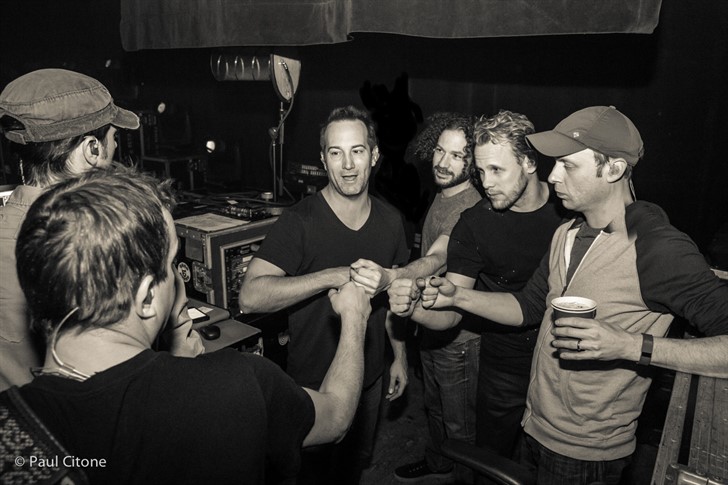
Umphrey’s first contemplated asking him to join back in the summer of 1999 when they were off attending the Montreal Jazz Festival and learned that Ali Baba’s original bass player Karl Engelmann had left the group. However, by the time Umphrey’s made it home, a new bassist was in place. By the following summer when Cinninger’s band encountered some additional lineup turmoil, Umphrey’s made their move.
“As a music fan, I’m not shy about getting down and riding the rail, going up close and seeing the music,” Stasik discloses. “When Jake was in his band, I was the guy right in front of him with his jaw on the floor, going, ‘Where did Eddie Van Halen come from? Who is this guy?’ I told Brendan: ‘If we’re going to make it, then this guy has to be in our band.’ He was, hands down, the best guitar player I had seen live at that point.”
Cummins recalls a moment at Mickey’s Pub in South Bend on April 1, 1999, when Cinninger sat in along with their friend Rich Cohen on alto saxophone. “We did ‘Cissy Strut,’ opened it up in the middle and got into this super weird Miles Davis improv space. I’d heard about musicians having out-of-body experiences, and that was my first one, although it only lasted about two minutes. But I felt we had arrived at a place we hadn’t been to before, and that happened when Jake was up there with us.”
Cinninger proved to be a catalyst not only due to his proficiency but also by virtue of his tastes. “I like Darkthrone black metal from Norway as much as I like Joe Pass jazz, and everything in between,” he explains. “I’ve got 5,000 records at home and I’ve been a collector since I could see above the bin at the record shop. So I think it’s a reflection of just being a true fan.”
He recalls first seeing Umphrey’s at Benchwarmers. “I was impressed because they had their own PA system, so they sounded good and it was packed. I walked in and I heard the song ‘Der Bluten Kat’ with its King Crimson angular riffing. I was blown away. And chicks were dancing to odd-meter rock-and-roll, which I thought was cool.”
Although Cinninger was the same age as his bandmates, he brought a unique set of experiences to bear. Prior to forming Ali Baba’s Tahini, he had honed his chops right out of high school at a honky- tonk saloon on the west side of South Bend. “I was a roadhouse guitarist, playing six sets a night—really grinding it out, like a jukebox. There was a time when I was playing and a crazy guy walked in off the street with a pistol and started pointing it at the band. Luckily, nothing happened, but there were some crazy situations.”
From there, he was recruited to join a group called Avalanche by an investor who cherry-picked top area musicians with the intent of creating a chart-topping country pop act. Cinninger estimates that the investor sunk over a million dollars into preproduction, enlisting high-end producers for the project, which soon gained traction with major labels. However, after Avalanche recorded a demo with 17 original songs, one of the members caused a fatal car wreck and everything fell apart.
“I went back home and I was going to go back to construction work and to live a normal blue-collar Midwest life,” Cinninger explains. “But then I decided to get Tahini going and started playing around South Bend, which is when Bayliss gave me a call. I could tell right away that things were going to work because we could write together and be very democratic and have a good shit-filter on the music. Everything’s been done in music, so you have to put your own fingerprint or twist on it, and we were good at finding these little riffs. I also noticed how quickly we were able to build our repertoire up with original music and keep adding logs to the fire. The beauty of having a band house meant that we could spend 6-7 hours a day grinding out new songs in that basement on Henderson St. in Wrigleyville.”
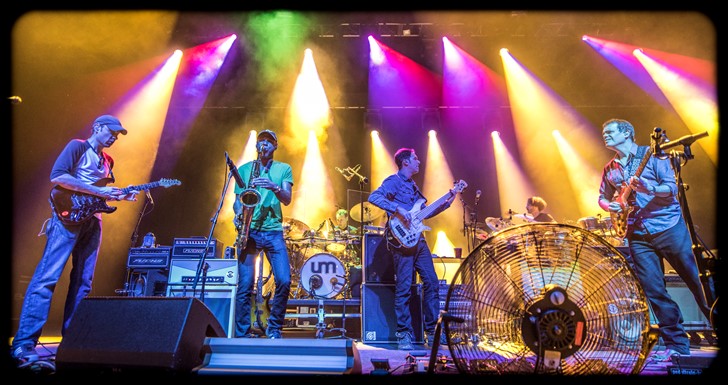 Joshua Redman joins the band in Oakland in 2015 (Jay Blakesberg)
Joshua Redman joins the band in Oakland in 2015 (Jay Blakesberg)
The current lineup finally coalesced in January 2003 when drummer Kris Myers debuted with Umphrey’s. A few months earlier, Mirro had sat the group down and told them that he intended to enter medical school. This resulted in a brief moment of crisis, upending even the perpetually sanguine Stasik. “I cried that night,” he acknowledges. “It was the first time that I was filled with anxiety about our future.” [Mirro, who attended classes at Loyola University but never completed his degree, later studied film scoring at Columbia College Chicago before he passed away in late-January 2014. The band continues to honor his memory, most recently before their encore at Penn’s Peak in Jim Thorpe, Pa., on Jan. 28, 2018].
“When Kris joined the band, it expanded the sonic palette, and that’s not to take anything away from how great a drummer Mike was,” Cummins observes. “With Kris’ general knowledge of everything from jazz to rock to metal, it’s almost like he was the perfect fit for what we wanted to be—and we almost didn’t know it. He also was able to get detail-oriented with everyone in the band about how we played as a group and make different observations about feel that he was really familiar with from having a master’s degree in jazz from DePaul.”
Stasik affirms, “After we met Kris and rehearsed with him, I was no longer worried that the band would continue to work hard and strive to move in the direction we are now.
“With Umphrey’s, sometimes people wonder if we know what our identity is, and I think that’s a fair question,” he continues. “What we’ve discovered is that our identity is a little bit of everything. We like metal, we like folk, we like hip-hop, we like the blues and we love rock-and-roll. So we try to dip our fingers in each of those in a way that makes sense. That’s really what’s sustained us—that and our families. A big shout out to them. It’s a very understanding wife who lets her husband come and go in the vampire lifestyle that we live, and for all of them to hold it down is pretty amazing.”
Over the past two decades, Umphrey’s McGee has maintained a stable road presence, performing more than 2000 shows, while steadily attaining notoriety along the way.
Looking back on the group’s earliest days, Stasik recalls, “Brendan and I had many beers and tears and drunk nights where we hugged, shook hands and said, ‘If we play Red Rocks, we’ll have made it.’”
The band accomplished that feat in 2005 with two nights on The String Cheese Incident’s Big Summer Classic tour. Umphrey’s returned the next year with moe. and in 2008 with Gov’t Mule before its first true headlining gig at the venue in 2010. Things escalated from there, as the group worked its way up to a three-show run in 2017, and will do so again this year. Other milestones have included notable festival appearances, additional amphitheater dates and prestigious stands, such as the aforementioned three nights at the Beacon.
However, one achievement that had long eluded the group was a studio album that proved to be as artistically satisfying as the band’s rousing, magnetic live shows. Not a note-for-note reproduction of those shows, but a recording that effectively transformed that inventiveness and fluency into another medium.
“Our first albums were very unprofessional,” Stasik contends. “We basically plugged in shitty mics and recorded live. Anchor Drops or Safety in Numbers is where we started to slowly understand the studio, although there were time constraints, so we played it really safe.”
The group’s most successful effort was 2009’s Mantis. On that recording, Umphrey’s fashioned a prog-infused sculpture of entirely new music. While this was a bold achievement in its own right, on some levels, it failed to reflect the sweeping artistry of the group, lacking the full complement of hues and limiting listeners’ emotional engagement with the music.
So when the band entered Chicago’s I.V. Labs Studio in November 2016, the point of reference was less Mantis than some of its earlier recordings, such as Anchor Drops or Local Band Does O.K.
While the group’s preceding record, 2016’s ZONKEY—which presented newly recorded versions of the band’s signature Halloween mash-ups—was sui generis, it did prove somewhat instructive. “The thing I realized when we were recording ZONKEY,” Cummins offers, “is that, for the most part, the instrumental sections of all the songs that were hits were super straightforward and simple things, which is the opposite of a lot of Umphrey’s music. ZONKEY also featured complex vocal harmonies and allowed us to highlight that part of the band in a way that our previous albums never had. That’s something we took with us, and you can hear more complex vocal arrangements than we’ve ever done on it’s not us.”
The impetus for the new record is the subject of a good-natured dispute. Bayliss points to a Chicago Cubs game he spontaneously attended on a rare Friday off, following a Thursday gig that led him to reflect on his life and relish the band’s forthcoming 20th anniversary—aspiring to celebrate it with the group’s fans not just by revisiting past glories, but also by presenting a new collection of material.
“We’ve been allowing Brendan to tell the story, but what he doesn’t know is that the rest of us had exchanged a bunch of emails before then and Kevin [Browning, who manages the group with Vince Iwinski] planted the seed on the day he went to the game,” Cummins counters with a chuckle.
What can be confirmed is that the band began recording in November 2016 a few days after the Cubs broke a 108-year fallow streak by winning the World Series. “I was still hungover when we started it and there was just a very jovial atmosphere,” Bayliss reveals. There was also a certain esprit de corps—while Bayliss was the lone band member still living in the city, the other musicians rented a five-bedroom apartment, harkening back to the communal living days of yore.
“It was a great experience,” Cummins attests. “We were super relaxed and way more organized than any time in the past. We had 25 ideas to start with that we’d all been listening to during the months leading up to it.”
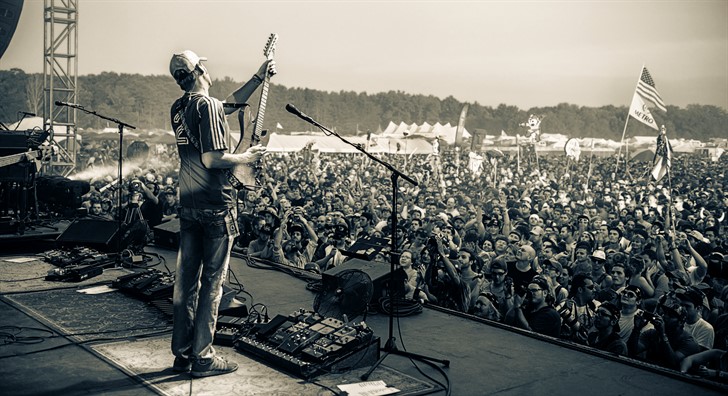 Local band does more than OK (Jay Blakesberg)
Local band does more than OK (Jay Blakesberg)
Cinninger also credits their collective experience in the studio. “By now, I feel that I’m as good of a producer as I am a guitarist. As the years go on, we’ve been fine-tuning these skills. It’s a never-ending puzzle, so I’m constantly immersing myself in microphones and pre-amps and compressors and limiters and EQs and effects units. By building confidence, we don’t have to think about it when we get into the studio. The less you think about it, the less likely you are to be psyched out by the studio, so the music comes pouring out. We let that vortex be a wide-open conduit for riffs and rhythms and melodies.
“It’s particularly important for us to not be afraid because we’re so versatile. To go into the studio and try something like ‘Dark Brush’ and then something like ‘You & You Alone’ is totally bi-polar—it’s not even the same band. That’s our magic trick, in a way—that we’re chameleon-like, where we can confidently pull off these styles back-to-back. We wanted to shape each of these songs like they were their own record, like a record inside of a record.”
it’s not us certainly achieves that goal. The album presents a wide spectrum of sounds, which, for Cinninger, is a literal description as well. Each of the songs evokes a unique color and texture to him, from the white-hot pink of “The Silent Type” through the midnight blue of “Looks,” the dandelion of “Whistle Kids,” the burnt sienna of “Half Delayed,” the silver of “Speak Up,” the ocean blue of “Piranhas” and the black tile of “Dark Brush.”
“It’s an album of contrasts,” Cummins offers. “‘Remind Me’ has this almost- ridiculous metal ending and then it goes right to acoustic guitars and a song by Brendan for his wife. ‘Whistle Kids’ revisits the looser, funkier Umphrey’s sound, while ‘Maybe Someday’ is super progressive with lots of parts and interesting meter and time changes.”
All told, it’s the ideal album for the 20-year mark, serving both as a summation of all that’s come and an opening statement for what’s to follow.
“I think this one really does encapsulate our variety because that’s one thing we’ve always been able to do.” Bayliss emphasizes. “We can do the acoustic-ballad thing, we can do the heavy-metal thing, we can do the funk thing. This album really captures that from track to track. If you don’t like metal and you like folk, it’s got that. If you don’t like folk and you like funk, it’s got that. And if you like prog, it’s got that and it’s all in 52 minutes. After all this time, I think we finally got it right.”
This article originally appears in the March 2018 issue of Relix. For more features, interviews, album reviews and more, subscribe here.



















